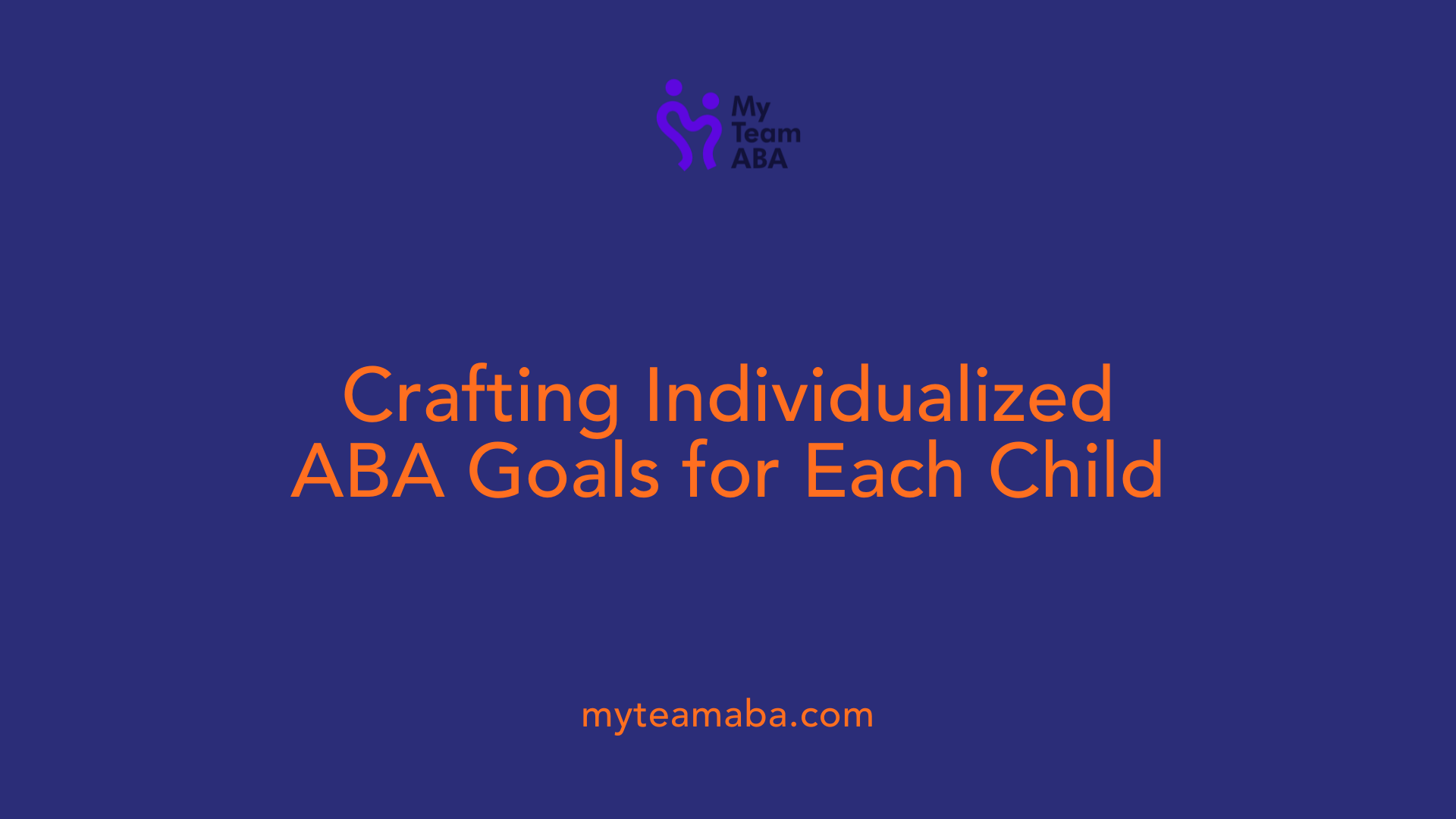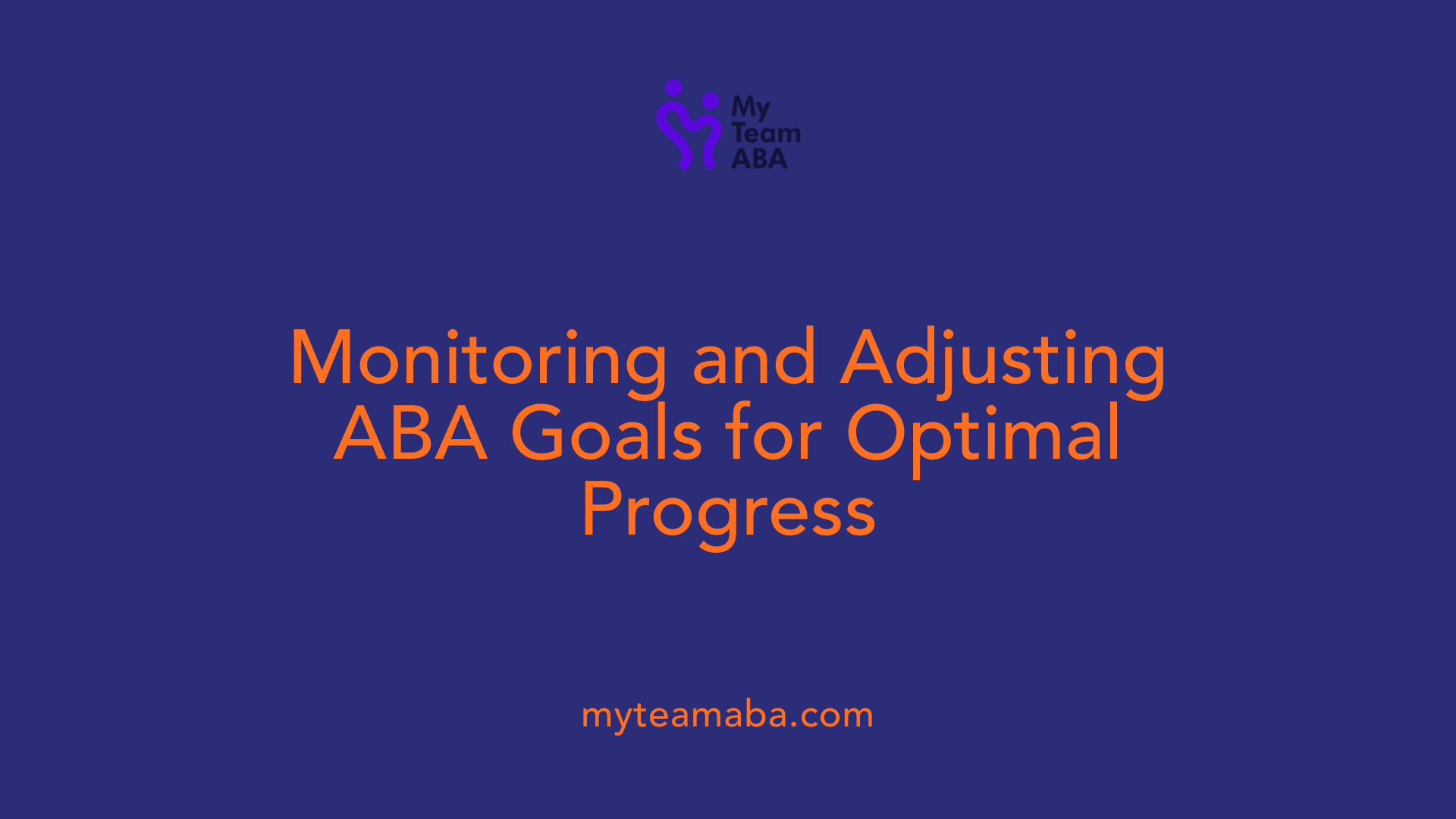The Importance of Individualized ABA Therapy Plans
November 2, 2025
Personalized Strategies in Autism Care: Unlocking Potential

The Power of Tailored ABA Therapy
Effective autism interventions hinge on understanding and addressing each individual's unique needs. Applied Behavior Analysis (ABA) stands out as a scientifically supported approach that, when personalized, can significantly enhance a child's development and quality of life. This article explores the critical role of individualized ABA therapy plans, emphasizing their creation, implementation, and environmental considerations.
Fundamentals of ABA and the Need for Personalization

What is ABA, and why is it important?
Applied Behavior Analysis (ABA) is a science-based approach that focuses on understanding how behavior works, how it's influenced by the environment, and how learning takes place.
Founded on decades of research since the 1960s, ABA uses proven techniques to help individuals develop essential skills. It plays a vital role in improving areas like communication, social skills, independence, and academic abilities.
How does ABA help understand behavior and environment?
By studying the relationship between actions (behavior), what happens before the behavior (antecedent), and what follows it (consequence), ABA provides a clear framework for behavior change. This understanding allows therapists to selectively modify environmental factors to encourage positive behaviors and reduce problematic ones.
What are the goals of ABA therapy?
ABA aims to increase helpful, functional behaviors such as language, social interaction, and daily living skills. It also seeks to decrease behaviors that interfere with learning or safety.
Therapy is adaptable and often includes a variety of strategies like positive reinforcement, which rewards desired behaviors to promote their repetition. The overarching goal is to foster greater independence and success across many areas of life.
Why is personalizing ABA programs so important?
Children and adults with autism are unique, with different strengths, challenges, and interests. Personalized ABA therapy plans are designed based on thorough assessments and involve setting specific, achievable goals tailored to each individual.
These customized plans include selecting suitable strategies and environment adjustments to match the person's learning style. Regular data collection helps track progress and adjust intervention strategies promptly.
Involving families and multidisciplinary teams ensures consistency across settings, enhances engagement, and promotes effective skill transfer to real-world situations.
An individualized approach not only addresses core symptoms but also supports overall development, making ABA the most effective intervention for many people with autism.
| Component | Purpose | Examples |
|---|---|---|
| Assessment | Understand individual needs | Standardized tests, observations, family input |
| Goal Setting | Define measurable, realistic objectives | Language development, social skills |
| Intervention Strategies | Tailored methods for behavior change | Positive reinforcement, environmental modifications |
| Data Monitoring | Track progress and guide adjustments | Regular record keeping, analysis |
| Family Collaboration | Ensure consistency and support | Training sessions, home programs |
Personalized ABA plans form a comprehensive, flexible framework that adapts as the individual grows and learns, maximizing the benefits of early intervention.
The Creation of Personalized ABA Goals and Treatment Plans

How are ABA therapy goals and treatment plans created and tailored for individual children?
Developing effective ABA therapy plans begins with thorough assessments performed by a trained behavior analyst, typically a Board Certified Behavior Analyst (BCBA). This initial step involves observing the child in various settings, conducting Functional Behavior Assessments (FBAs), and collecting input from parents, caregivers, teachers, and other professionals involved in the child's life.
The assessments aim to uncover the child's strengths, challenges, motivators, and developmental stage. For example, identifying specific behaviors that interfere with learning or social interaction helps to prioritize goals. Importantly, these plans are highly individualized, ensuring they are relevant and attainable for the child's unique needs.
Once assessment data is gathered, the BCBA collaborates with families and other team members to develop tailored goals. These goals are made SMART—specific, measurable, achievable, relevant, and time-bound. For instance, a goal might be to increase the child's ability to request items verbally rather than through gestures.
To create manageable steps toward these goals, techniques such as task analysis and behavior chaining are employed. Task analysis breaks a complex skill into smaller, teachable components, while behavior chaining sequences these components into a functional behavior. These techniques ensure the child can gradually master skills in a structured way.
Throughout therapy, continuous data collection — including frequency, duration, and quality of behaviors — guides ongoing adjustments. Regular progress monitoring allows therapists to identify what strategies work best and modify interventions as needed.
Family involvement plays a vital role. Families are engaged during goal-setting to ensure points of relevance, daily routines, and environmental factors are incorporated. This collaboration ensures that the treatment plan aligns with the child's natural context, making it easier to generalize skills across settings.
In summary, personalized ABA plans are crafted through a detailed assessment process, data-driven goal development, and collaborative planning. These strategies help ensure that each child's therapy is relevant, targeted, and adaptable to support meaningful progress and skill acquisition in their everyday life.
The Role and Responsibilities of ABA Therapists

What role do ABA therapists play in developing and implementing customized treatment strategies?
ABA therapists are fundamental in creating and executing tailored intervention plans for individuals with developmental or behavioral challenges, especially those on the autism spectrum. They begin with thorough assessments to understand each person's strengths, needs, and specific behaviors. These assessments help identify target skills and behaviors for intervention.
Once the assessment stage is complete, therapists work closely with families and other professionals, such as speech or occupational therapists, to set clear, measurable goals. These goals are personalized, focusing on areas like communication, social skills, independence, or reducing problematic behaviors.
Developing evidence-based strategies involves using techniques like positive reinforcement, prompting, shaping, and functional communication training. These approaches are flexible and adapted to the individual's preferences and learning style.
Throughout therapy, ABA therapists systematically collect data on behavior frequency, duration, and quality. This data is crucial for tracking progress and determining whether the current strategies are effective.
Based on the data, therapists make ongoing adjustments to intervention plans to maximize benefits. They might modify teaching methods, goals, or reinforcement schedules as needed.
A critical aspect of their role is teaching skills that can be applied in real-life environments. They work to generalize learned behaviors beyond therapy sessions, supporting individuals in various settings such as home, school, or community.
Therapists also focus on building practical skills that promote independence and everyday functioning, ensuring that therapies are relevant and impactful.
Supported by oversight from qualified behavior analysts, ABA therapists implement scientifically grounded strategies designed to help individuals reach their full potential. Their work promotes meaningful improvements across multiple areas of development and quality of life.
Environmental Considerations and Skill Generalization

Why are environmental considerations important in developing personalized ABA therapy goals?
In ABA therapy, understanding the child's environment and routines is fundamental to creating effective and relevant intervention goals. Each child's daily life is shaped by various settings—home, school, community—and these environments influence behaviors significantly.
Assessing these contexts helps therapists identify when and where behaviors occur, ensuring that goals are practical and applicable. For example, learning to communicate during playtime or transitioning smoothly in classroom routines makes therapy more meaningful.
Adapting goals based on environmental factors ensures skills learned in therapy are not limited to clinical settings but are transferable to real-world situations. This alignment increases the likelihood that the child will generalize skills across different environments, promoting independence.
Moreover, involving families and caregivers in the assessment process helps tailor interventions that respect the child's preferred routines and surroundings. By doing so, therapy becomes more engaging and effective, as it integrates seamlessly into daily life.
Ultimately, considering the child's environment during goal development enhances the relevance and sustainability of ABA therapy, leading to better outcomes in daily functioning and social participation.
How can therapy adapt to different environmental factors?
Adjusting goals and strategies to fit various environmental contexts involves ongoing observation and collaboration. Therapists often modify intervention techniques to suit specific settings or changes in routines.
For instance, a child might respond well to communication goals in a quiet, familiar environment but might need adjusted strategies during noisy or busy times. Real-time data collection helps therapists identify these needs and refine their approaches.
Flexibility is key—interventions should be dynamic, evolving with the child's environmental circumstances and developmental progress. Family training and community-based programs also support this adaptability.
By fostering consistency across settings, ABA therapists help children develop skills that are functional and sustainable, encouraging success in everyday life.
Promoting skill generalization across different settings
Skill generalization is the process of transferring learned skills from one setting to others, such as from home to school or community environments.
ABA therapy actively promotes this by designing goals that consider multiple contexts, ensuring that skills are not context-specific but adaptable to new situations.
Techniques like practicing in various environments, involving different people, and using natural cues help facilitate this transfer. For example, teaching a child to greet peers at school and in community settings ensures that social skills are applicable broadly.
Consistent reinforcement and routine practice across environments reinforce the child's ability to use skills independently and confidently.
Effective collaboration with families, teachers, and community members ensures everyone supports the generalization process, leading to more consistent behavior and skill use across different parts of the child's life.
| Aspect | Focus | Impact |
|---|---|---|
| Environment assessment | Understanding routines and settings | Tailors goals to real-life contexts |
| Goal adaptation | Flexibility based on environment | Enhances relevance and transferability |
| Skill generalization | Across settings and people | Supports independence and functional use of skills |
Benefits of Personalization and Family Involvement

What are the benefits of personalized ABA therapy approaches for children with autism?
Customized ABA therapy is highly effective because it considers each child's unique strengths, challenges, and interests. This personalized approach ensures that interventions are relevant and engaging, promoting better learning and behavioral outcomes.
By tailoring goals and strategies, ABA helps children develop essential skills such as communication, social interaction, independence, and daily living skills. It also focuses on reducing problematic behaviors that interfere with learning or daily activities.
Scientific research supports the effectiveness of individualized ABA programs in fostering improvement in language, academic abilities, and social participation. Early, tailored intervention can lead to meaningful gains, providing a solid foundation for future development.
Flexibility is another benefit—a personalized plan can be delivered in different settings like home, school, or community, adapting to the child's environment and needs. This ensures that therapy remains accessible and applicable across various life areas.
Involving families in creating and implementing personalized ABA plans greatly enhances success. When caregivers participate actively, they help maintain consistency and support skill generalization. This collaboration empowers families, making them active partners in their child's progress and promoting long-term positive outcomes.
Overall, the individualized nature of ABA maximizes engagement, motivation, and effectiveness, helping children with autism reach their full potential.
Monitoring Progress and Continuous Adjustment in ABA Therapy

How are ABA therapy goals and treatment plans created and tailored for individual children?
ABA therapy plans are personalized through detailed assessments by a qualified behavior analyst, often a BCBA. These assessments involve observing the child, conducting functional behavior assessments, and collecting input from families and other caregivers.
Based on this information, therapists can identify the child's strengths, challenges, motivators, and developmental stage. This helps in designing goals that are specific, measurable, and achievable, aligning with the child's daily life and developmental needs.
The goals are broken down into smaller steps using strategies like task analysis and behavior chaining, making progress manageable and clear. These might include improving communication, social skills, or reducing problematic behaviors based on what the child needs most.
Family involvement is critical, as it ensures that interventions fit into the child's home environment and routines. The treatment plan is a dynamic document, continuously guided by ongoing data collection during therapy sessions.
This data helps monitor progress, pinpoint what is working, and reveal when adjustments are needed. As the child develops and responds to treatment, goals and strategies can be updated to maintain relevance and foster continued growth.
How does data collection influence therapy adjustments?
Systematic data collection is at the heart of ABA therapy. Therapists record specific observations related to each goal, such as frequency, duration, and context of targeted behaviors.
This continuous data collection allows therapists to analyze patterns over time. If data shows that a behavior is decreasing or a skill is improving, the current strategies are reinforced.
Conversely, if progress stalls or behaviors worsen, therapists may modify their approach. For example, they might adjust reinforcement schedules, change instructional methods, or revisit foundational skills.
The real-time data enables precise decision-making, ensuring interventions remain effective.
How do therapists ensure that goals stay relevant?
Relevance of goals is maintained through regular reviews and ongoing assessments. Data analysis helps determine whether goals are still appropriate or need refinement.
Goals are also revisited during team meetings involving families and multidisciplinary professionals, ensuring they align with the child's evolving needs and environment.
Adjustments may include expanding skill areas, setting new targets, or simplifying goals based on the child's current development level.
This adaptive process guarantees that ABA therapy remains targeted, motivating, and effective, promoting consistent progress towards independence and life skills.
| Aspect | Method | Purpose | Typical Actions |
|---|---|---|---|
| Goal creation | Functional assessments, family input | Tailor programs to individual needs | Develop personalized, measurable goals |
| Data collection | Frequency counts, observations, charts | Track progress and inform adjustments | Record behavior, analyze trends |
| Adjustments | Data review, team meetings | Ensure ongoing relevance and effectiveness | Modify goals, strategies, reinforcement plans |
| Reassessment | Regular formal reviews | Keep therapy aligned with developmental changes | Update goals, adjust intervention Plans |
Integrating Scientific Evidence and Ongoing Professional Development
 Research over decades has consistently demonstrated that ABA therapy is highly effective in improving skills and reducing problematic behaviors among individuals with autism spectrum disorder (ASD). Scientific studies support its role in enhancing intellectual functioning, language abilities, daily living skills, and social interactions. This robust evidence underscores the importance of adhering to proven methods and continuously updating therapeutic practices.
Research over decades has consistently demonstrated that ABA therapy is highly effective in improving skills and reducing problematic behaviors among individuals with autism spectrum disorder (ASD). Scientific studies support its role in enhancing intellectual functioning, language abilities, daily living skills, and social interactions. This robust evidence underscores the importance of adhering to proven methods and continuously updating therapeutic practices.
Staying current with advancements in ABA techniques and research is vital for ensuring the best outcomes. The field evolves as new research uncovers innovative interventions and refinements to existing strategies. Therapists must engage in ongoing education—through workshops, conferences, and courses—to remain informed about the latest developments.
The role of ongoing training for ABA therapists is crucial. It enables professionals to refine their skills, incorporate new evidence-based approaches, and adapt to changing individual needs. Continuous professional development ensures that therapy remains effective, culturally responsive, and tailored to each person’s unique circumstances. Such commitment to learning fosters improved intervention quality, ultimately leading to better life skills, independence, and overall well-being for those served.
| Aspect | Details | Importance |
|---|---|---|
| Research support | Long-standing scientific validation for ABA effectiveness | Confirms therapy's reliability and encourages best practices |
| Keeping current | Adapting to new findings and techniques | Ensures the most effective, evidence-based interventions |
| Therapist training | Regular professional development | Enhances skills, responsiveness, and therapy outcomes |
By integrating current research with ongoing education, ABA practitioners maintain high standards of care and foster continual growth in their capacity to serve individuals with ASD effectively.
Empowering Development Through Tailored Intervention
Individualized ABA therapy plans are fundamental to maximizing developmental gains for children with autism. These plans, rooted in scientific principles and crafted through thorough assessments, consider environmental influences and leverage family involvement to ensure relevance and effectiveness. As therapists adapt strategies in response to ongoing data, children are provided with personalized pathways toward greater independence, improved skills, and enhanced quality of life. Embracing the personalized nature of ABA not only fosters better outcomes but also empowers families and professionals to work collaboratively towards each child's full potential.
References
- Applied Behavior Analysis (ABA) | Autism Speaks
- The Importance of ABA Therapy Goals
- What Role Do ABA Therapists Play? - Quality Behavior Solutions
- The Importance of Tailored ABA Treatment Plans for Your Child
- ABA Therapy - Individualized Treatment - The SEED Center
- The Role of ABA Therapy in Treating Challenging Behaviors
- Personalized ABA Treatment Plans: How They're Crafted
- ABA Therapy Goals: 25 Practical Examples & Timelines
